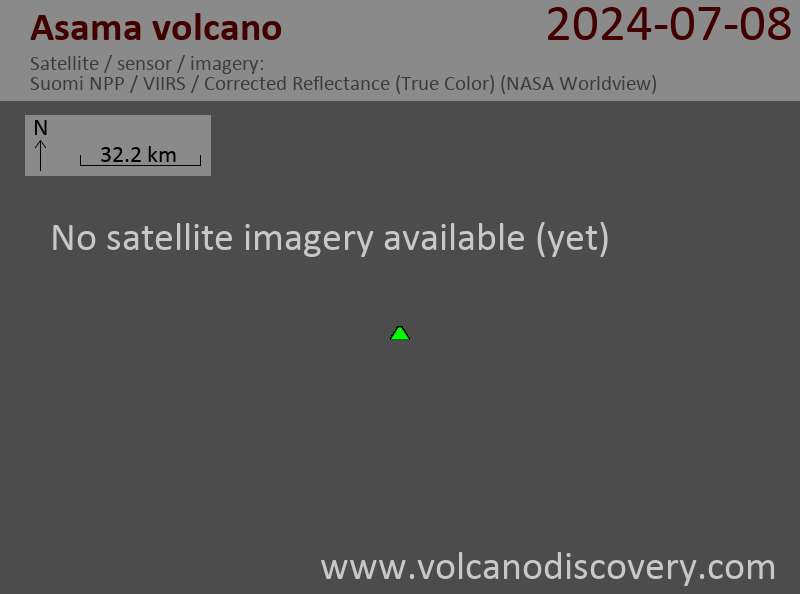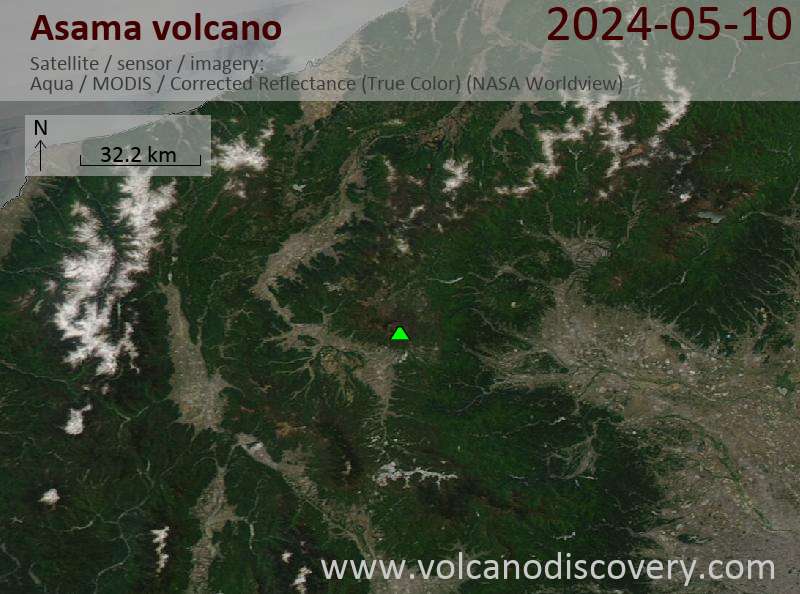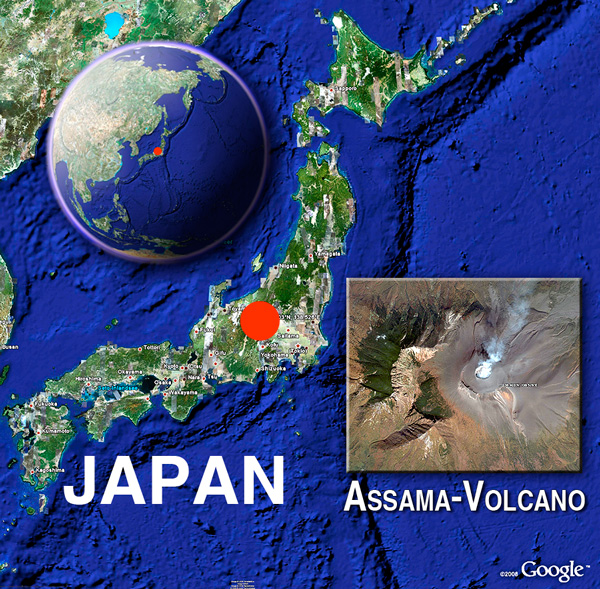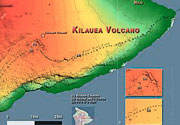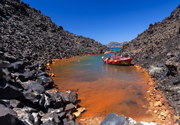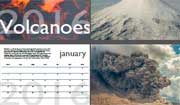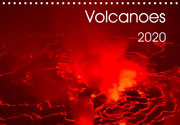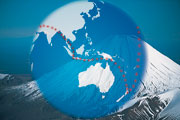Asama Volcano
Updated: Apr 28, 2024 07:27 GMT -
complex volcano 2568 m / 8,425 ft
Honshu (Japan), 36.4°N / 138.53°E
Current status: normal or dormant (1 out of 5)
Honshu (Japan), 36.4°N / 138.53°E
Current status: normal or dormant (1 out of 5)
Last update: 19 Apr 2023 (Smithsonian / USGS Weekly Volcanic Activity Report)
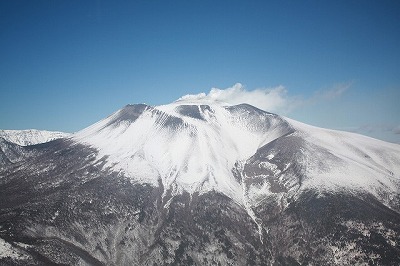
Asamayama volcano (JMA)
Asama (or Asamayama) volcano is the most active volcano of Honshu and one of the volcanoes with the longest recorded history of documented eruptions. It is located 130 km from Tokyo in central Honshu, overlooking the resort town of Karuizawa.
Asama's activity is typically explosive, including frequent strombolian to vulcanian activity. It has had several major eruptions, including 2 plinian eruptions in 1108 and 1783 AD.
[smaller] [larger]
Asama volcano eruptions: 2019, 2015, 2009, 2008, 2004, 2003, 1990, 1983, 1982, 1982, 1973, 1965, 1961, 1958-59, 1953-55, 1952, 1952, 1950-51, 1949, 1947, 1946, 1944-45, 1938-42, 1935-37, 1934, 1934, 1933, 1931-32, 1930, 1929, 1929, 1927-28, 1924, 1922, 1920-21, 1919, 1918(?), 1917, 1916, 1915, 1914, 1909-14, 1908, 1908, 1907, 1907, 1906, 1905(?), 1904, 1903, 1902, 1902, 1900-01, 1899, 1899, 1894, 1889, 1879, 1878(?), 1875, 1869, 1815, 1803, 1803, 1783, 1779(?), 1777, 1776, 1769, 1762, 1755, 1754, 1733, 1732, 1731, 1729, 1729, 1728, 1723, 1723, 1722, 1721, 1720, 1719, 1718, 1717, 1711, 1710, 1708-09, 1706, 1704, 1703, 1669, 1661, 1661, 1660, 1659, 1658, 1657, 1656, 1655, 1653, 1652, 1651, 1650(?), 1649, 1648, 1648, 1647, 1645, 1644, 1609, 1605, 1604, 1600, 1598, 1597, 1596, 1596, 1595(?), 1591, 1590, 1532, 1528, 1527, 1518, 1427(?), 1281, 1108, 887, 685
Latest nearby earthquakes
| Time | Mag. / Depth | Distance / Location | |||
| Apr 17, 09:48 am (GMT +9) | 2.5 152 km | 19 km (12 mi) to the E | Info | ||
| Sunday, April 14, 2024 GMT (1 quake) | |||||
| Apr 14, 04:46 pm (GMT +9) | 2.7 163 km | 14 km (8.6 mi) to the NE | Info | ||
Background
from: Asama volcano information (Smithsonian GVP)Asama volcano is located at the junction of the Izu-Marianas and NE Japan volcanic arcs. The modern cone of Maekake-yama forms the summit of the volcano and is situated east of the horseshoe-shaped remnant of an older andesitic volcano, Kurofu-yama, which was destroyed by a late-Pleistocene landslide about 20,000 years before present (BP). Growth of a dacitic shield volcano was accompanied by pumiceous pyroclastic flows, the largest of which occurred about 14,000-11,000 years BP, and by growth of the Ko-Asama-yama lava dome on the east flank. Maekake-yama, capped by the Kama-yama pyroclastic cone that forms the present summit of the volcano, is probably only a few thousand years old and has an historical record dating back at least to the 11th century AD. Maekake-yama has had several major plinian eruptions, the last two of which occurred in 1108 (Asama's largest Holocene eruption) and 1783 AD.
Eruptions of Asama volcano
2009 Eruption
Following record levels of SO2 emission (up to 5,000 tons per day), Asama volcano erupted on 2 February at 1:51 am local time. The eruption produced an ash plume rising 2 km and many bombs which fell up to 1 km from the crater. Light ash fall reached Tokyo, 145 km SE of the volcano, and beyond.
Following record levels of SO2 emission (up to 5,000 tons per day), Asama volcano erupted on 2 February at 1:51 am local time. The eruption produced an ash plume rising 2 km and many bombs which fell up to 1 km from the crater. Light ash fall reached Tokyo, 145 km SE of the volcano, and beyond.
2008 activity
3 small ash eruptions were observed at Asama volcano in August 2008, the first activity since 2004.
3 small ash eruptions were observed at Asama volcano in August 2008, the first activity since 2004.
2004 vulcanian eruption
A large single vulcanian explosion occurred at Asama volcano at 20:02 local time on 1 September 2004. It was stated to be the largest eruption in over 20 years. ...more info
A large single vulcanian explosion occurred at Asama volcano at 20:02 local time on 1 September 2004. It was stated to be the largest eruption in over 20 years. ...more info
1990-2003 activity: steaming and earthquakes, minor ash emissions
Most of the period from 1990-2003, Asama was comparably quiet, with only steam emission and several earthquakes swarms.
Such periods of earthquake swarms peaked in April 1991, April 1995 and June 1996, when more than 1000 earthquakes were recorded, but not followed by eruptions.
Periods of heightened seismicity were also recorded during September 2000 and June 2002.
4 minor ash eruptions occurred during February-April 2003.
(Source: GVP monthly reports)
Most of the period from 1990-2003, Asama was comparably quiet, with only steam emission and several earthquakes swarms.
Such periods of earthquake swarms peaked in April 1991, April 1995 and June 1996, when more than 1000 earthquakes were recorded, but not followed by eruptions.
Periods of heightened seismicity were also recorded during September 2000 and June 2002.
4 minor ash eruptions occurred during February-April 2003.
(Source: GVP monthly reports)
1983 summit crater eruption
An explosive summit eruption occurred on 8 April 1983, producing incandescent tephra and a large ash plume reaching probably 5 km height. Fine ash fell to the ENE in up to 250 km distance from the volcano.
An explosive summit eruption occurred on 8 April 1983, producing incandescent tephra and a large ash plume reaching probably 5 km height. Fine ash fell to the ENE in up to 250 km distance from the volcano.
1982 eruption
2 explosive eruptions occurred at the summit of Asama volcano on 26 April, 2 October at 02:25 and 05:48 local time. The eruptions produced a small pyroclastic flow and fine ash fall in Tokyo, 130 km to the SE, for the first time in 23 years. ...more info
2 explosive eruptions occurred at the summit of Asama volcano on 26 April, 2 October at 02:25 and 05:48 local time. The eruptions produced a small pyroclastic flow and fine ash fall in Tokyo, 130 km to the SE, for the first time in 23 years. ...more info
1973 eruption
A powerful eruption occurred on 1 February 1973, the first since 1961. ...more info
A powerful eruption occurred on 1 February 1973, the first since 1961. ...more info
1783 subplinian eruption
The large eruption of Asama volcano in 1783 was one of Japan's largest and most destructive eruptions in the past 1000 years. It started with sporadic ash ejections beginning 9 May, and gradually increased in intensity.
After late July, the eruption became continuous, forming a huge plinian ash cloud that blackened out the eastern sky and was full of heavy thunder and lightning. Powerful shock waves shook houses and caused panic.
The eruption culminated in a series of very powerful explosions starting on 4 August, and terminated with a giant explosion at about 10 am on 5 August, which could be heard 300 km away.
The eruption produced highly destructive and very unusual pyroclastic flows, heavy ash and pumice falls, large lava flows and built a cone. It completely destroyed 4 villages, thousands of houses, and killed about 1400 people. ...more info
The large eruption of Asama volcano in 1783 was one of Japan's largest and most destructive eruptions in the past 1000 years. It started with sporadic ash ejections beginning 9 May, and gradually increased in intensity.
After late July, the eruption became continuous, forming a huge plinian ash cloud that blackened out the eastern sky and was full of heavy thunder and lightning. Powerful shock waves shook houses and caused panic.
The eruption culminated in a series of very powerful explosions starting on 4 August, and terminated with a giant explosion at about 10 am on 5 August, which could be heard 300 km away.
The eruption produced highly destructive and very unusual pyroclastic flows, heavy ash and pumice falls, large lava flows and built a cone. It completely destroyed 4 villages, thousands of houses, and killed about 1400 people. ...more info





